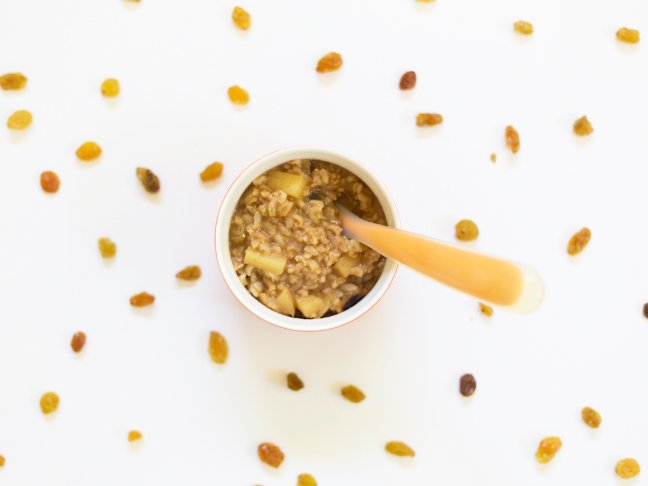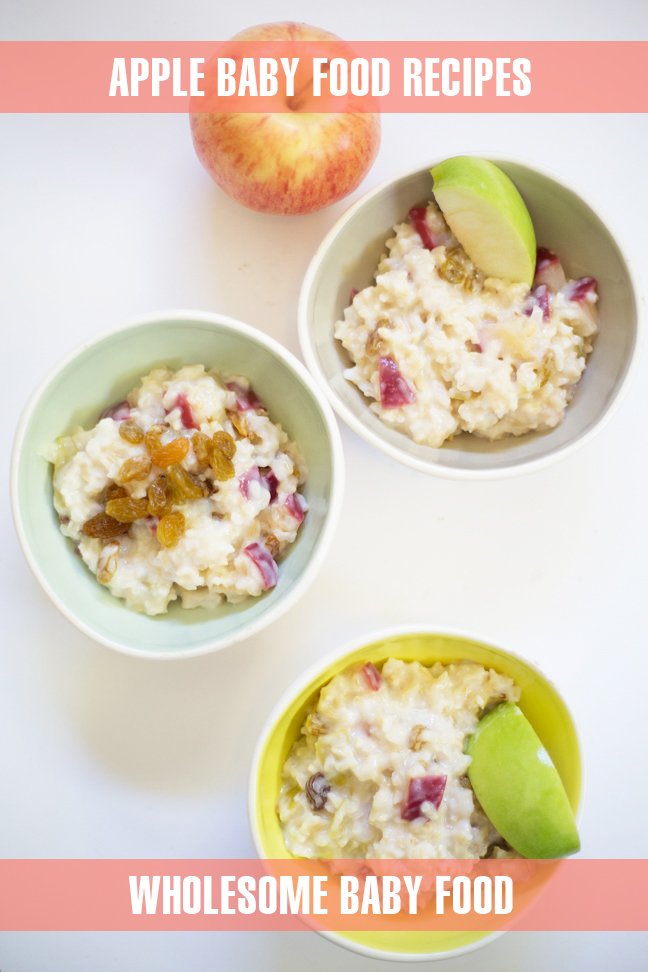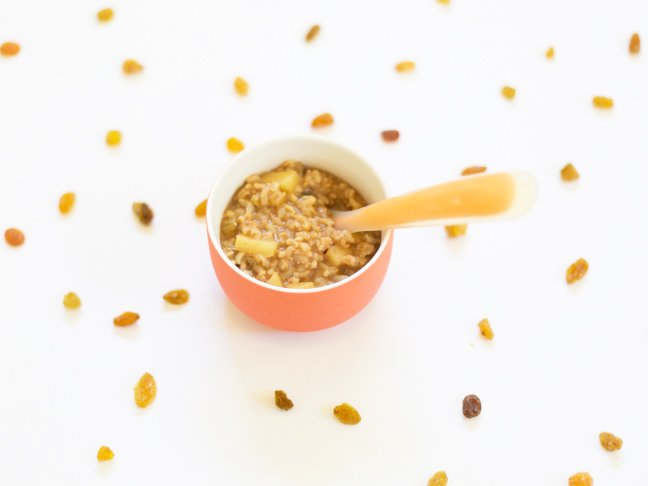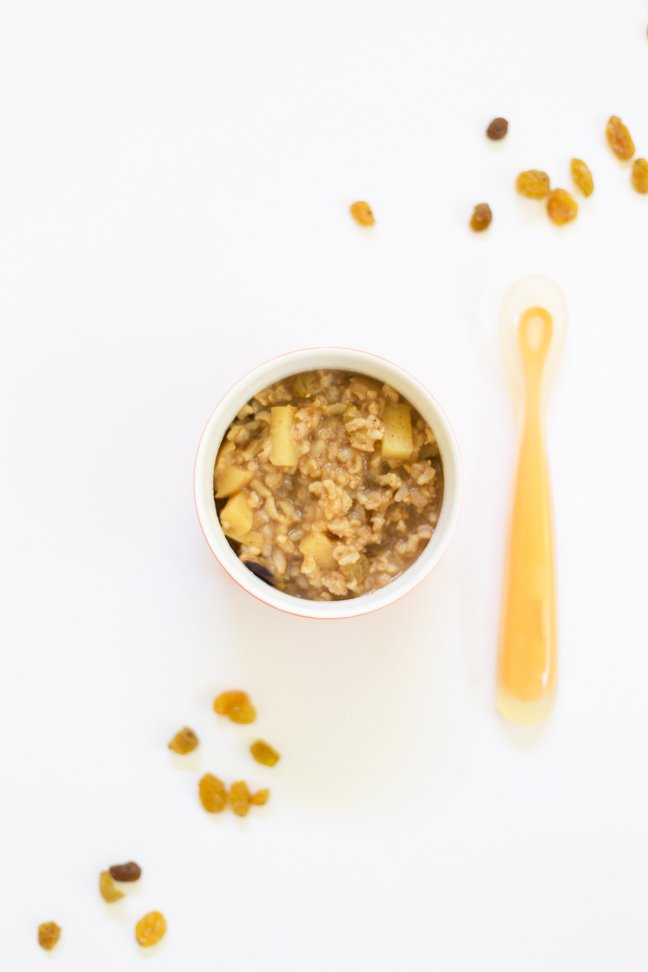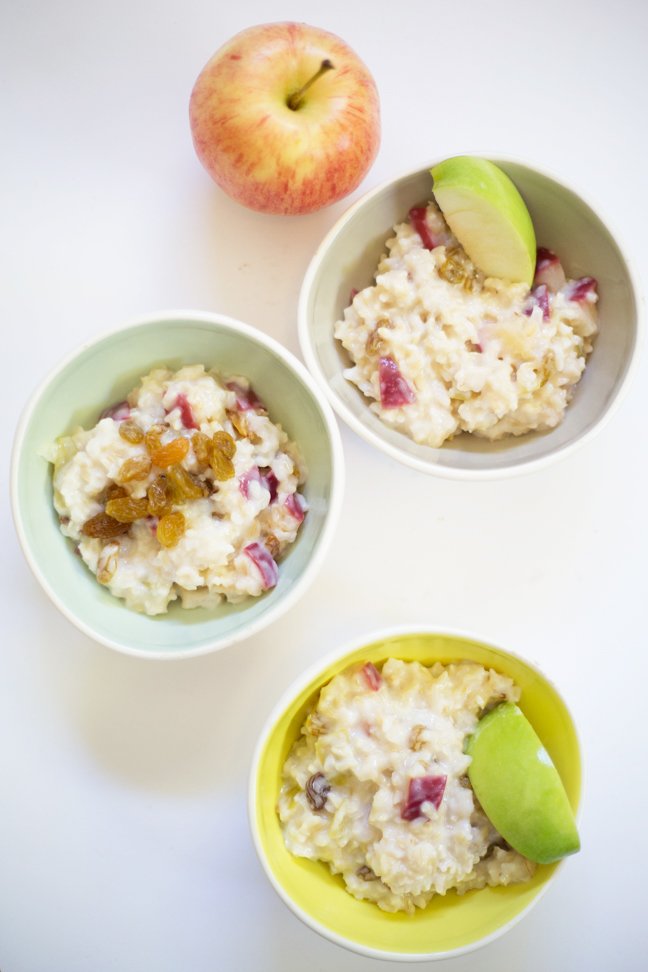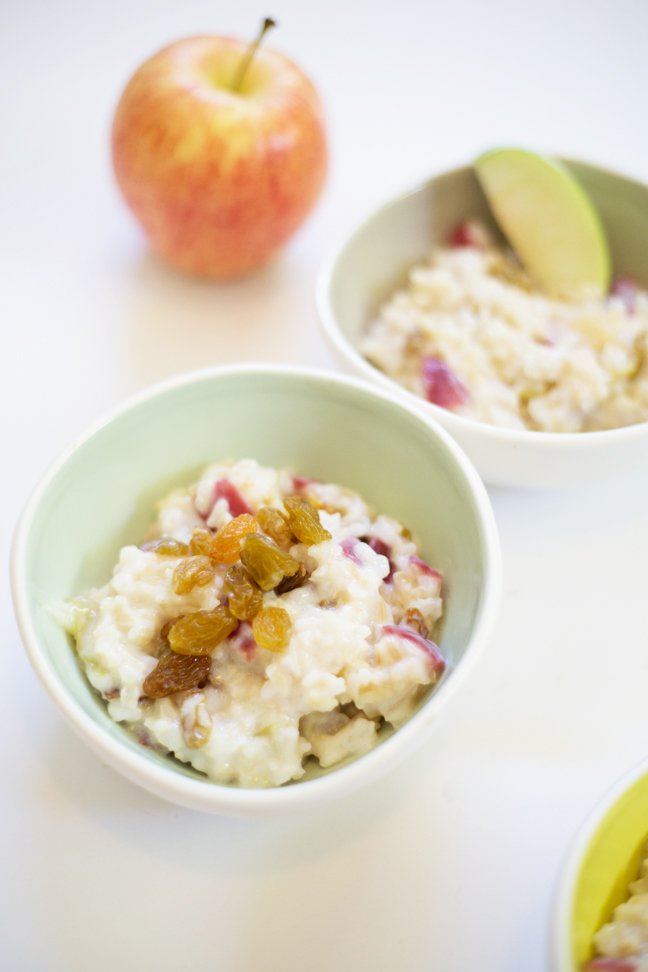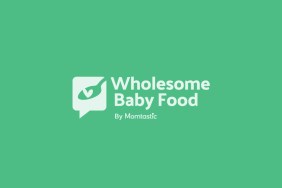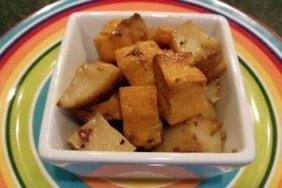The goodness of apples for baby:
“An Apple a Day” as the old saying goes is indeed good for your health. Apples are truly a wonder fruit and they may be one on your baby’s first foods.
One of the most important nutritional components of Apples is that they contain two types of fiber; insoluble fiber and soluble fiber. Both the insoluble fiber in apples and their soluble fiber pectin, help maintain bowel regularity (thus helping to prevent diverticulosis and colon cancer). The insoluble fiber works like roughage, while the soluble fiber (pectin), helps keep the bowels regular (avoiding constipation, avoiding diarrhea) and specifically affects the makeup of the stool. Pectin will firm up the stool as it is a soluble fiber.
While the study of apples’ health benefits is still in very early stages, research to date suggests that apples and apple nutrients may play a role in promoting human health in a number of ways. Apples may help maintain good healthy by promoting cardiovascular health by lowering LDL cholesterol and inhibiting LDL oxidation, and reducing the risk of certain types of stroke; maintaining a healthy weight, as part of a low-fat, fiber-rich diet; promoting lung health, by countering the effects of oxidative damage; promoting prostate, liver and colon health, by inhibiting the growth of related cancer tumors; and promoting bone health, by providing a good source of the dietary mineral boron.
Do apples need to be peeled for babies and homemade baby food recipes?
Always peel apples that you will be serving raw as finger foods until you feel your toddler is able to handle the peels.
The following applies to apples that you will be cooking and mashing or pureeing: Apples should be peeled for babies under 8 months of age to ensure that there are no tummy upsets. Your baby should do fine with apple skins after 8 months of age. Of course there are many babies who do fine with apples that have the skin on, so please use your own judgement.
|
Nutrients in apples (one medium apple) |
|
| VITAMINS: Vitamin A – 73 IUVitamin C – 9 mg
Folate (important during pregnancy) – 4 mcg Vitamin E – .66 IU |
MINERALS: Potassium – 158 mgCalcium – 9.5 mg
Phosphorus – 9.5 mg Magnesium – 7 mg Selenium – .4 mg Also contains small amounts of iron, manganese, copper and zinc. |
When can I introduce Apples to my baby?
Apples are a great choice for one of an infant’s first food. They are easy to prepare, easy to digest and are full of nutrients. Apples are also very versatile and may be added to almost any baby recipe you find. You can mix apples with cereals, veggie purees, with meat purees and use them in teething biscuit recipes, in healthy cake recipes, in yogurt and mixed with other fruits also.
![]() Apples are also great when frozen, added to a Baby Safe Feeder and used as a teething reliever. Applesauce is a great substitute for oil in many baked goods recipes.
Apples are also great when frozen, added to a Baby Safe Feeder and used as a teething reliever. Applesauce is a great substitute for oil in many baked goods recipes.
How to select the perfect apples for baby food recipes
 According to the EWG, apples are one of the “dirty dozen” foods that are most highly contaminated with pesticides – purchasing organic is a smart choice.
According to the EWG, apples are one of the “dirty dozen” foods that are most highly contaminated with pesticides – purchasing organic is a smart choice.
Select apples that are firm and have no squishy indentations. Apple skin should not be discolored (uneven coloring is the hallmark of many apples so do not mistake discoloration for normal coloring) or have cuts and bruises.
Store apples in the refrigerator and only cut them when you are ready to cook or otherwise use them.
The best way to cook apples for baby food recipes
Apples are most flavorful and tasty when they are baked. You may also steam apples to retain the most of their nutrients. Boiling apples in a scant amount of water is another way to cook apples. Apples are very juicy and will seem to “boil down” as you are steaming or boiling them. This is great because you will probably not need to add any water to make baby’s applesauce. Add some spices as they are cooking for extra tasty-yum.
Apple baby food recipes
Puréed Apples/Applesauce for babies 4-6 months 
Ingredients:
- Any amount of apples you desire – I recommend using 5-10 large apples (try Macintosh, Gala or Braeburn.)
Directions:
Step 1: Peel, core and cut apple into slices/chunks
Step 2: Place slices or chunks into a pan with just enough water to slightly cover apples
Step 3: Boil/steam until tender; be sure to check on the water level and stir.
That’s it! Easy peasy.
Apples may be mashed with a potato masher to achieve a smooth applesauce consistency. If your masher will not achieve a puree consistency, then follow steps 4 – 7:
Step 4: Reserve any left over water to use for thinning out the apples
Step 5: Place into your choice of appliance for pureeing and begin pureeing
Step 6: Add the reserved water as necessary to achieve a smooth, thin puree
Step 7: Add cereal (if desired) to thicken up the puree
Ask your pediatrician about adding some cinnamon for new flavors.
HINT: You may also buy an “Adult” jar of natural applesauce from your local grocers. Make sure you buy natural applesauce however. Read the labels if you are unsure. The only ingredients should be apples and water, or just apples. A few companies may add ascorbic acid (vitamin C) or citric acid to their natural applesauce; this is fine.
Mixed Apple Purée/Applesauce Baby Food Recipe for babies 4-6 months 
Ingredients:
- 1/2 cup water
- 5 medium apples (1 Macintosh, 1 Granny Smith, 1 Braeburn, 2 Fuji)
Directions:
Step 1: Core, peel, and dice apples
Step 2: Add pinch of cinnamon and drop of vanilla if desired
Step 3: Combine all ingredients in large saucepan and bring to a gentle boil
Step 4: Lower heat and simmer until “sauce” like consistency is achieved; ensure that you check on the liquid level.
Step 5: Mash, strain and puree the resulting “sauce” as needed – May be frozen in ice cube trays for baby food cubes
Baked Apples for Baby for babies 4-6 months 
Ingredients:
- Any amount of apples you desire – I recommend using 5-10 large apples (try Macintosh, Gala or Braeburn.)
- A small amount of butter (1 tablespoon or less)
Step 1: Core apples and leave peel on (without the peel, the apple will turn to mush)
Step 2: Place a wee bit of butter (8 months + if baby is ready for or has had dairy) on the inside of the cored apple (8 months+ – sprinkle a bit of cinnamon in the apple if your desire and if baby is ready for or has had cinnamon)
Step 3: Place in a shallow baking or roasting pan with a bit of water – about an inch or 2 of water
Step 4: Bake in a 400-degree oven for 30 minutes or until tender; be sure to check on the water level.
Step 5: Once baked, allow to cool and then slip off the skin if needed. You may either cut apple into little bits and serve as a finger food or mash as directed above in the apples/applesauce recipe.
Oats & Apple Cereal for babies 4-6 months 
Ingredients:
- 1 small apple
- 1/4 cup ground oats
- 3/4 cup water
Directions:
Step 1: Peel, core and cut a small apple into small dices
Step 2: Place in a pan with 1/4 c ground oats and 3/4 c water
Step 3: Bring mixture to a slow boil. Simmer covered, checking frequently, until apples are soft and oatmeal is cooked
Step 4: Be sure to stir and mash while cooking
Step 5: Mix in formula or breast milk or juice to thin if needed – puree if necessary
(Sprinkle a bit of cinnamon in the cereal if your desire and if baby is ready for or has had cinnamon.)
Apple Grain Breakfast Salad Baby Food Recipe for babies 8-10 months 
Ingredients:
- 3 cups water
- 1/4 teaspoon salt (omit if needed)
- 3/4 cup quick-cooking brown rice
- 3/4 cup bulgur wheat
- 1 Granny Smith apple
- 1 Red Delicious apple
- 1 large peach
- 1 cup raisins
- 1 container (8-ounce) low fat vanilla or plain yogurt
Directions:
Step 1: In a large pot, heat water and salt to boiling over high heat. Add rice and bulgur; reduce heat to low, cover, and cook for 10 minutes.
Step 2: Remove from heat and set aside, covered, for 2 minutes
Step 3: Spread hot grains on baking sheet to cool (this will make them fluffier). Grains can be prepared the night before and kept refrigerated.
Step 4: Just before serving, prepare fruit: Core and chop apples; peel orange or peach and cut into sections.
Step 5: Add apples and/or peach, and raisins to grain mixture.
Step 6: Stir in yogurt to coat grains and fruit. Sprinkle with wheat germ.
Ensure that you use soft ripe fruits when serving to babies 8 months of age + and be sure the texture is manageable for baby.
Variation for those 8 months +
Step 1: Cook grains for 30 minutes then add diced apples, diced peach and chopped raisins.
Step 2: Return to cooking for another 15 minutes or until everything is soggy and cereal-like. Keep a close watch on the pot as you may need to add more water. Stir often.
Step 3: Just before serving, stir in yogurt of an amount you desire. Sprinkle with wheat germ.
Apple Baby Food Recipes – Yummy Apples -n- Chicken for babies 8-10 months 
Reserve this recipe for when your pediatrician says baby can have meats.
Ingredients:
- 2 cups water
- 1 cup apples – peeled, cored and diced
- 1 chicken breast – uncooked and diced
Directions:
Step 1: In a medium saucepan, combine water, apple dices and chicken breast. Slowly bring to a boil
Step 2: Turn heat down to low and simmer for 20 minutes or until chicken is no longer pink and has been fully cooked. Fork test for tenderness
Step 3: Chop or puree as needed for your baby’s texture preferences
*Add rice or star pasta for a hearty meal.*
Rice Breakfast Pudding with Apples for babies 8-10 months 
Ingredients:
- 1/2 cup (Brown/or Jasmine) Rice (grind to barley size – don’t grind if serving to a Toddler )
- 2 cups water
- 1/4 cup apples sliced into small dices or slivers
- 1/4 cup raisins (optional)
- 1/8 cup brown sugar (optional)
- 2 tsp cinnamon
- 1/2 tsp ginger
Directions:
Step 1: Combine all of the above ingredients in a medium saucepan
Step 2: Cook over medium-low heat for 30 minutes or until rice is soft, fragrant and a bit soupy
Step 3: Stir 1/8 cup milk into the rice, keep on heat for 10 more minutes. Keep a close watch to ensure that the consistency remains soupy but not pasty.
Step 4: Stir frequently to stop sticking to the pot and add more milk or water if necessary
Step 5: Serve warm then transfer remaining portion to the fridge
Foods Good to Mix With Apples for Your Baby
- Rice, Oatmeal, Barley and Mixed Grain Homemade Baby Cereals
- Bananas
- Avocado
- Blueberries
- Pears
- Sweet Potatoes
- Carrots
- Summer Squash – Zucchini, Yellow (Crooked Neck)
- Chicken
- Beef
- Yogurt
ORAL ALLERGY SYNDROME |
|---|
| The food on this page may be one involving OAS. OAS occurs when a person sensitive/allergic to pollen develops a reaction to fruits/veggies that have a similar type of pollen. Itching & swelling of the lips, the mouth and/or throat are typical symptoms. These symptoms normally appear within minutes of eating the offending food and may be worse during the spring and fall pollen seasons. Rarely is an OAS life threatening. Click below to learn more. |
| Birch Pollen Allergies |
| Birch pollen allergies are associated with apple, carrot, cherry, pear, peach, plum, fennel, walnut, potato, spinach, buckwheat, peanut, honey, celery, and kiwifruit. |
| Cedar Allergies |
| Japanese cedar allergies are associated with melon, apple, peach and kiwifruit. |
| Mugwort Allergies |
| Mugwort allergies are associated with celery, carrot, spices, melon, watermelon, apple, hazelnut, and chestnut. |
| Grass Pollen |
| Grass pollen allergies are associated with melon, tomato, watermelon, orange, rice and cherry. |
| Ragweed Pollen |
| Ragweed allergies are associated with melon, chamomile, honey, banana, and sunflower seeds. |
| Latex |
| Latex allergies may be cross-reactive to banana, avocado, kiwi and papaya. |
![]() Remember, always consult with your pediatrician regarding introducing solid foods to your baby and specifically discuss any foods that may pose allergy risks for your baby.
Remember, always consult with your pediatrician regarding introducing solid foods to your baby and specifically discuss any foods that may pose allergy risks for your baby.
![]() This site complies with the HONcode standard for trustworthy health information: verify here.
This site complies with the HONcode standard for trustworthy health information: verify here.
